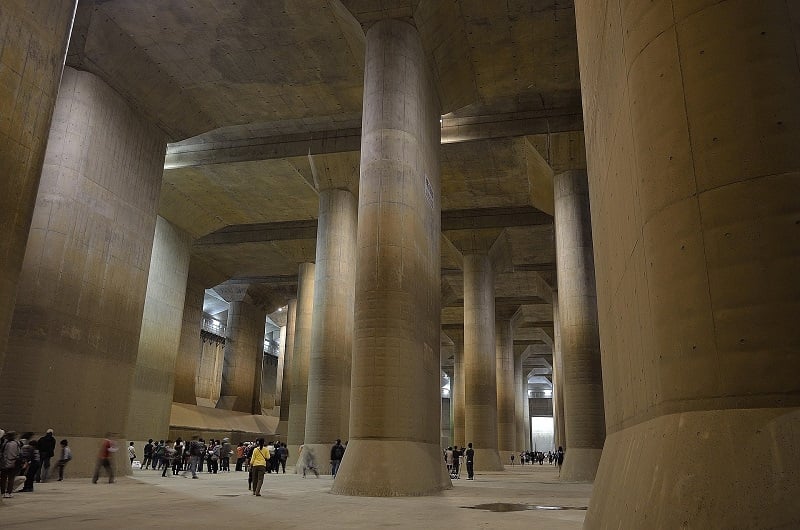The first time we heard of a massive “Underground Temple” in Tokyo Greater Area, images of Shinto shrines and bright red torii gates flooded (you’ll get this pun soon enough) our travel-hungry minds. We couldn’t have been more wrong.
In engineering, architecture, and technology, Japan is nothing short of a trailblazer; and this is something that Tokyo’s Underground Temple embodies. Let us bring you there virtually, in case you haven’t been. These fun facts about Tokyo’s Underground Temple will surely blow your mind!
Also read: 30 Useful Japanese Phrases You Need to Learn Before Travelling to Japan [UPDATED 2021]

Image credit: AMANO Jun-ichi
1. It’s actually not a temple
…nor is it a “cathedral,” as some call it. What we’re looking at is actually a massive flood tunnel system officially named the Metropolitan Area Outer Underground Discharge Channel or G-CANS for short.
While it has the sole purpose of protecting Japan’s densest cities from devastating floods, it doesn’t hurt that it’s structurally a beaut. Many note its resemblance to ancient Greece’s ruins, most especially the Parthenon. Because of this likeness, people have come to know it as Tokyo’s Underground Temple or even Tokyo’s Underground Cathedral. We must admit, it does look like a very bare Roman chapel.
2. It’s so gigantic it almost feels unreal
Where do we even begin to describe the utter ‘mammoth-ness’ of Tokyo’s Underground Temple?
Picture this: The flood tunnel system, made up of a main discharge tank (or channel) plus five other silos (or chambers), is built to receive raging floodwater from all the rivers that cut through the Kanto Plain — Japan’s largest flatland covering around 17,000 kilometres. It protects a highly urbanised, populated zone referred to as Tokyo Greater Area, which includes Central Tokyo, Kanagawa, Chiba, and Saitama.
The main discharge tank of Tokyo’s Underground Temple is what you’ll often see in photos. It stretches a whopping 177 metres, with 59 larger-than-life pillars supporting its cavernous ceiling. Each pillar weighs 500 tonnes, and standing next to one will make you look like an ant. How much water can the main discharge tank hold? A mind-boggling 13 billion gallons of water, we kid you not.
There’s nothing small about the smaller five silos that run the length of the entire structure either. With a depth of 70 metres each, the chambers can easily fit the Statue of Liberty or even a NASA space shuttle. We’ll leave that to your imagination. But you should know that something of this size and quality took 13 years to build. Construction began in 1993; Tokyo’s Underground Temple was presented to the public in 2006.
3. It releases water into the Edo River
Now you might be wondering: Where does all that water go? It’s released into the Edo River north of Tokyo. To save lower-lying areas that boast a population of about 38 million, water has to be released upstream.
Tokyo’s Underground Temple features four water pumps that run on 14,000 horsepower each. To make it simpler, imagine the water held by an Olympic-size swimming pool. Given these high-powered pumps, water should easily drain in about 12 seconds. We’ll give you a minute to process that and pick up your jaws.
Also read: In the Middle of Nowhere: This Japanese Train Station Reminds Passengers to Pause
4. It put Japan on the map as a disaster risk & reduction authority
These commercial areas in Tokyo Greater Area add up to trillions of yen in value, so it’s easy to understand why Japan took to great lengths to protect them from natural disasters. Since it was completed in 2006, Tokyo’s Underground Temple has been a pilgrimage site of sorts to engineering experts worldwide. Whether for study or leisure, they can’t get enough of it.
Yet, most of them will tell you that climate change is no longer what it was in 1993. Will Tokyo’s Underground Temple withstand the test of time? I guess only time will tell.
5. You can tour the place!
Perhaps the most exciting fact we can tell you is, you can actually tour the place! Should you find yourself in Saitama, don’t miss the chance to book an Underground Temple tour. A quick Google search will reveal all the interesting walking tours you can take around the area, which certainly spotlight this engineering marvel.

Image credit: Dddeco
In case Tokyo’s Underground Temple looks familiar, you might have just seen it in anime, J-pop music videos, manga, and even Hollywood productions. Have you watched Hunger Games: Mockingjay? Then you’ll have surely gotten a glimpse of this gem in Tokyo. Don’t you want to see it in person, too?




